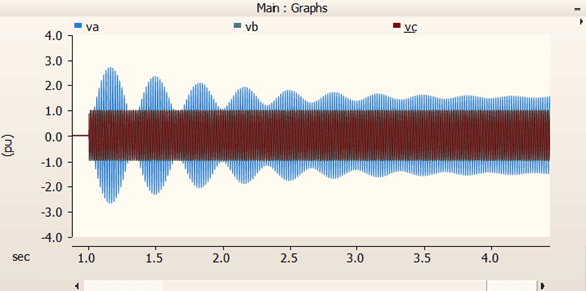
Delivering a stable and reliable source of power comes with an array of challenges. Among them is parallel line resonance that can occur in shunt compensated transmission lines during unbalanced switching operations. The resulting excessive resonant over-voltage can severely damage the line-connected devices. Therefore, paying special attention to determining the shunt reactor size, switching plan, and mitigations is vital.
Energy suppliers are among the essential pillars upon which modern civilization stands. They power everything from the smallest handheld devices to our vast communication networks and breathe life into entire cities.
However, distributing power is a delicate and sophisticated challenge. Utilities implement various tools and measures to achieve peak efficiency. Yet, in the quest for stabilizing power, the very measures we put in place can themselves destabilize transmission. Effects like excessive over-voltage can damage vital equipment and ultimately, reduce the efficiency and cost-effectiveness of transmission or even halt operations entirely.
While stabilizing power is a complex challenge, it’s not insurmountable. Finding a lasting solution(s) for the grid involves careful planning and integrating the right countermeasures.
In this blog, we zero in on the issue of parallel line resonance associated with shunt compensated long transmission lines. We explain how this can occur and its impacts on the grid. Finally, we explain how to determine optimal mitigation strategies to stabilize grid operations.
Stabilizing the grid
Before diving into the specifics of parallel line resonance and shunt reactors, we need to cover some basics about energy transmission.
Active and reactive power
Active power, measured in kilowatts (KW), is what powers our devices. Whereas reactive power, measured in kilovolt ampere reactive (KVAr)—the result of the energy exchanged between the capacitive and inductive elements in the network—has zero net energy transferred to the load.
Reactive power compensation
While reactive power does not directly power our devices, it maintains the electromagnetic field and strongly influences the voltage levels across the grid. Reactive power compensation is the process of adjusting reactive power flow for voltage control to ensure efficient delivery of active power. A key tool we use to achieve this is a shunt reactor.
The shunt reactor’s role
Transmission lines inherently have capacitance due to the conductors’ insulation, and capacitance’s effect on the voltage level increases as it flows through the line. In a light-loaded or no-load long transmission line, due to the reactive power provided by the distributed capacitor along the line, the voltage at the receiving end of the line is higher than the voltage at the sending point. This phenomenon is referred to as the Ferranti effect.
Shunt reactors are typically used in long transmission lines for voltage regulation by absorbing the reactive power. They’re installed at key points along the line terminals near the substation or mid-point of the line. Typical degrees of shunt compensation—which is the ratio of the shunt reactor MVAR to line charging MVAR—are in the range of 60% to 80% [1], [2].
However, accounting for reactive power in active lines doesn’t cover all the bases.
Parallel line resonance due to stuck breaker condition
The energization of a transmission line begins with the switching mechanism. A three-phase circuit breaker will close, thereby enabling power to travel through the three-phase conductors, although sometimes breakers fail or get stuck.
The natural frequency of the asymmetrically opened transmission line depends on the line shunt compensation level and the uneven breaker pole operations. A parallel resonance circuit, where the shunt reactor on the open phase interacts with a closed phase through mutual capacitive coupling (due to the electromagnetic field), can result in severe resonant over-voltage on the open phase. This phenomenon is referred to as parallel resonance due to a “stuck breaker,” which can occur if the natural frequency of the open phase is near the fundamental frequency.
The presence of parallel line resonance can be observed in the following conditions [3]:
- One pole or two breaker poles of the breaker fail to operate during line energization/de-energization.
- Disconnection of one circuit in a double-circuit line configuration.
Fundamental frequency, steady state, and high-induced voltages can occur when one breaker pole either fails to open or close and the energized phase(s) couple energy into the de-energized phase(s). High over-voltage can occur on de-energized phase(s) of the same circuit or adjacent circuits and can damage the line-connected equipment if it exceeds the continuous voltage rating.
Figure 1 illustrates the excessive over-voltage following the energization of a 500 kV transmission line with an energizing breaker stuck on phase A, the transmission line is 100 km long with 80% shunt compensation at the line terminal.

Figure 1. Excessive over-voltage following the energization of a 500 kV transmission line with a breaker stuck on phase A
Without the proper measures in place, the excessive over-voltage following the energization of the open transmission line can lead to severe damage to nearby equipment.
Planning ahead
Stabilizing power is a balance between strength and resistance. From generation to distribution, increasing and decreasing power is simply part of operations. Another crucial consideration is that equipment does not always function as intended.
Nothing a little foresight can’t handle.
Using computer modeling and simulation tools (e.g., PSCAD/EMTDC), we can determine the necessary size of the shunt reactor, experiment with different switching scenarios, and ultimately predict potential resonance conditions.
This kind of software makes it possible to integrate the proper measures to counteract challenges like over-voltage resulting from parallel line resonance triggered by unbalanced switching operations before the system goes online. With the data gathered from the simulations, we can formulate a mitigation strategy and integrate additional solutions like neutral reactors. [4].
Balancing the lines
Mitigation is a daily practice in supplying energy. Operating a system that enables the distribution of Kilowatts-worth of power safely and reliably requires meticulous planning and research.
While determining the shunt reactor size, switching plan, and other mitigations for transmission lines is a small piece of the puzzle, it’s critical to handle it correctly.
Need help balancing your grid?
The Power Network experts at PSC can determine exactly which measures to implement. We combine our professional insights with cutting-edge technology to help our clients make the best decisions for their valuable infrastructure—enabling them to efficiently provide their customers with reliable power.
References
[1] S. A. AI Rashed, S. N. AI Sohaibani, A. Clerici, “380 kV System from Riyadh to Qassim: Studies of Temporary Overvoltages and Methods to Prevent them”, Proceedings of Cigre 1990 session, Paris, Feance, paper 33-206, 1990.
[2] M. Swidan, M. Awad, H. Said, F. Rizk, “Temporary Overvoltage Measurements in the 500/400kV Interconnection System”, Proceedings of Cigre 1990 session, Paris, France, paper 33-103, 1990.
[3] M. V. Escudero and M. Redfern, “Parametric analysis of parallel resonance on shunt compensated transmission lines,” 39th International Universities Power Engineering Conference, 2004. UPEC 2004., Bristol, UK, 2004, pp. 1181-1185 vol. 2.
[4] Escudero, Marta Val, and Miles Redfern. “Effects of transmission line construction on resonance in shunt compensated EHV lines.” IPST, Montreal, Canada (2005).
